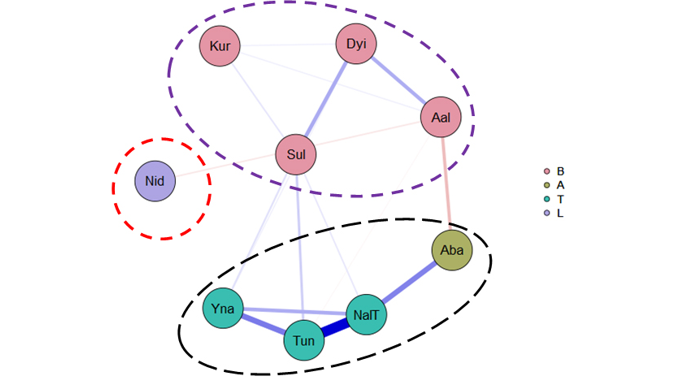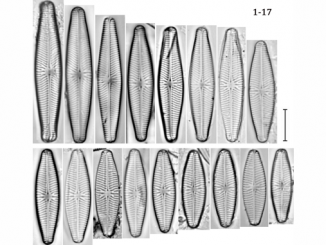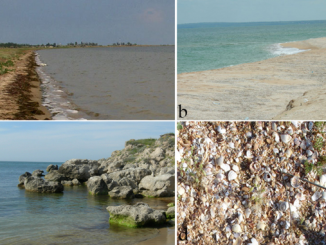
Paper category: Original research paper
Corresponding author: Sophia Barinova (sophia@evo.haifa.ac.il)
DOI: 10.1515/ohs-2020-0010
Received: 03/10/2019
Accepted: 02/12/2019
Full text: here
Citation (APA style): Oceanological and Hydrobiological Studies, Volume 49, Issue 2, Pages 99–122, eISSN 1897-3191, ISSN 1730-413X, DOI: https://doi.org/10.1515/ohs-2020-0010.
Abstract
A total of 437 species (453 with infraspecific taxa) of algae and Cyanobacteria were identified in 2034 samples collected during the first research on nine thermokarst lakes in Yakutia carried out in 1986–1994 and 2001–2015. The richest algal flora was determined in Lake Aalah, represented by 241 taxa. Bacillariophyta species dominated in four lakes, whereas Chlorophyta and Cyanobacteria dominated in the others. The algal bioindication demonstrated preferences for benthic and planktic-benthic life, temperate temperature, low alkalinity, waters with moderate oxygenation, low to medium enrichment with chloride, low organic pollution, and mesotrophic state. Comparative floristic, CANOCO and JASP statistical methods divided the species and environmental variables into groups of lakes related to landscape terraces. Local landscape positions and high summer water temperatures may play a major role in the formation of algal flora. The index of algae taxa per area stabilized at about 70 species per km2. The highest polymorphism of algae floras, defined by the Subspecies/Species Index, was determined for the lakes of the Tungulunskaya terrace: Lake Ynakh, Lake Nal Tungulu and Lake Tungulu (1.041–1.058), and the average total flora was 1.036. Our results can help in monitoring and protecting the ecosystems of thermokarst lakes in Yakutia in the harsh climate environment of Northeastern Eurasia.
References
Alekin, O.A., Semenov, A.D. & Skopintsev, B.A. (1973). Manual on the chemical analysis of land waters. Leningrad, Russia: Gidrometeoizdat. (In Russian).
Barinova, S. (2011). The effect of altitude on distribution of freshwater algae in continental Israel. Current Topics in Plant Biology 12: 89–95.
Barinova, S., Gabyshev, V. & Gabysheva, O. (2014). Climate impact of freshwater biodiversity: general patterns in extreme environments of North-Eastern Siberia (Russia). British Journal of Environment and Climate Change 4(4): 423–443.
Barinova, S., Gabyshev, V., Boboev, M., Kukhaleishvili, L. & Bilous, O. (2015). Algal Indication of Climatic Gradients. American Journal of Environmental Protection. Special Issue: Applied Ecology: Problems, Innovations 4(3–1): 72–77, DOI: 10.11648/j.ajep.s.2015040301.22.
Barinova, S., Keshri, J.P., Ghosh, S. & Sikdar, J. (2012). The influence of the monsoon climate on phytoplankton in the Shibpukur pool of Shiva temple in Burdwan, West Bengal, India. Limnological Review 2(2): 47–63. DOI: 10.2478/v10194-011-0044-y.
Barinova, S. & Kukhaleishvili, L. (2014). Diversity and ecology of algae and cyanobacteria in the Aragvi River, Georgia. The Journal of Biodiversity. Photon 113: 305–338.
Barinova, S. & Kukhaleishvili, L. (2017). Diversity and ecology of algae and cyanobacteria in the Enguri River, Georgia. Elixir Bio Science 104: 45934–45947.
Barinova, S. & Niyatbekov, T. (2018). Alpha-biodiversity of nondiatom algae in the Pamir aquatic habitats, Tajikistan. Biodiversity International Journal 2(3): 236–363. DOI: 10.15406/bij.2018.02.00065.
Barinova, S. & Niyatbekov, T. (2019). Comparative Analysis of Diatom Algae Diversity in the Pamir Protected Lakes, Tajikistan. International Journal of Advanced Research in Botany 5(2): 1–17. DOI: 10.20431/2455-4316.0502001.
Barinova, S. & Stenina, A. (2013). Ecological adaptation of diatoms in the Arctic lakes of the Kostyanoi Nos Cape (Nenezky Natural Reserve, Russian North). Plant Biosystems 147(2): 397–410.
Barinova, S.S., Bilous, O.P. & Tsarenko, P.M. (2019). Algal indication of water bodies in Ukraine: methods and prospects. Haifa, Kyiv, Israel: Publishing House of Haifa University. (In Russian).
Barinova, S.S., Kukhaleishvili, L., Nevo, E. & Janelidze, Z. (2011). Diversity and ecology of algae in the Algeti National Park as a part of the Georgian system of protected areas. Turkish Journal of Botany 35: 729-774. DOI: 10.3906/bot-1009-83.
Barinova, S.S., Medvedeva, L.A. & Anisimova, O.V. (2006). Diversity of algal indicators in the environmental assessment. Tel Aviv, Israel: Pilies Studio. (In Russian).
Danilova, N.S. (Ed.) (2005). Diversity of the plant world of Yakutia. Novosibirsk, Russia: Publishing House of SB RAS. (In Russian).
Decree of the Government of the Republic of Sakha (Yakutia) of January 15, 2016 No. 7 “On Approval of the Model Regulations on Unique Lakes of the Republic of Sakha (Yakutia)”. (In Russian).
Fomin, G.S. (1995). Water. Control of chemical, bacterial and radiation safety according to international standards. Moscow, Russia: NGO “Alternative”. (In Russian).
Genkal, S.I., Bondarenko, N.A. & Schoor, L.A. (2011). Diatoms of the lakes of the south and north of Eastern Siberia. Rybinsk, Russia: Print House. (In Russian).
Genkal, S.I., Chekryzheva, T.A. & Komulainen, S.F. (2015). Diatoms of ponds and watercourses of Karelia. Moscow, Russia: Scientific world. (In Russian).
Genkal, S.I. & Vekhov, N.V. (2007). Diatom algae of the Russian Arctic. Moscow, Russia: Nauka (In Russian).
Ghosh, S., Barinova, S. & Keshri, J.P. (2012). Diversity and seasonal variation of phytoplankton community in the Santragachi Lake, West Bengal, India. QScinece Connect 3: 1–19.
Guidance on hydrobiological monitoring of surface ecosystems. (1992). St. Petersburg, Russia: Hydrometeoizdat. (In Russian).
Guiry, M.D. & Guiry, G.M. (2019). AlgaeBase World-wide electronic publication. Galway, Ireland: National University of Ireland. Available at http://www.algaebase.org 24.06.2019.
Jiyenbekov, A., Barinova, S., Bigaliev, A., Nurashov, S., Sametova, E. et al. (2018). Algal comparative floristic of the Alakol Lake Natural State Reserve and other lakes in Kazakhstan. MOJ Ecology & Environmental Sciences 3(4): 252–258.
Kiselev, I.A. (1935). Phytoplankton of the lakes of Central Yakutia based on limnological survey 1932. In Studies of the lakes of the USSR (pp. 51–84). Leningrad, Moscow, Russia: Publishing in State Hydrol. Institute (In Russian).
Komarenko, L.E. & Vasilyeva, I.I. (1975). Freshwater diatoms and blue-green algae of Yakutia water bodies. Moscow, Russia: Nauka. (In Russian).
Komarenko, L.E. & Vasilyeva, I.I. (1978). Freshwater green algae of water bodies of Yakutia. Moscow, Russia: Nauka. (In Russian).
Komulainen, S.F. (2004). Ecology of phytoperiphyton of small rivers of East Fennoscandia. Petrozavodsk, Russia: Publishing house of the Karelian Research Center of the Russian Academy of Sciences. (In Russian).
Kopyrina, L.I. (2014). Epiphytic algae of the lakes of the Tuymaada valley in Central Yakutia. Novosibirsk, Russia: Nauka. (In Russian).
Krakhmalny, A.F. (2011). Dinoophyta algae of Ukraine (illustrated guide). Kiev, Ukraine: Alterpress.
Krammer K. (1997a). Die cymbelloiden Diatomeen. Teil 1. Allgemeines und Encyonema part. Bibl. Diatomologica. Bd. 36: 1–382.
Krammer, K. (1997b). Die cymbelloiden Diatomeen. Teil 2. Encyonema part., Encyonopsis und Cymbellopsis. Bibl. Diatomologica, Bd. 37: 1–469.
Krammer, K. (2000). Diatoms of Europe, Pinnularia, Vol. 1. Königstein, Germany: A.R.G. Gantner Verlag Kommanditgesellschaft.
Krammer, K. (2002). Diatoms of Europe. Cymbella, Vol. 3. Jena, Germany: Gustav Fischer Verlag.
Krammer, K. (2003). Diatoms of Europe. Cymbopleura, Delicata, Navicymbula, Gomphocymbellopsis, Afrocymbella Vol. 4. Jena, Germany: Gustav Fischer Verlag.
Krammer, K. & Lange-Bertalot, H. (1991b). Achnanthaceae, Kritische Ergänzungen zu Navicula (Lineolatae) und Gomphonema Gesamtliteratur verzeichnis Teil 1–4. Bacillariophyceae. T. 4. Stuttgart, Jena, Germany: Gustav Fischer Verlag.
Krammer, K. & Lange-Bertalot, H. (1988). Bacillariaceae, Epithemiaceae, Surirellaceae, Bacillariophyceae T. 2. Jena, Germany: Gustav Fischer Verlag.
Krammer, K. & Lange-Bertalot, H. (1991a). Centrales, Fragilariaceae, Eunotiaceae, Bacillariophyceae, T. 3. Stuttgart, Jena: Gustav Fischer Verlag.
Krammer, K. & Lange-Bertalot, H. (1986). Naviculaceae, Bacillariophyceae, T. 1. Jena, Germany: Gustav Fischer Verlag.
Kulikovsky, M.S., Glushchenko, A.M., Genkal, S.I. & Kuznetsova, I.V. (2016). Key to diatoms of Russia. Yaroslavl, Russia: Filigran. (In Russian).
Kuznetsova, L.V. Zakharova, V.I., Sosina, N.K., Nikolin, E.G., Ivanova E.I. et al. (2010). Flora of Yakutia: Composition and Ecological Structure. In E. Troeva, A. Isaev, M. Cherosov, N. Karpov (Eds.), The Far North. Plant and Vegetation, vol. 3. (pp. 24–140). Dordrecht: Springer (In Russian).
Lange-Bertalot, H. (2001). Diatoms of Europe. Navicula sensu stricto, 10 genera separated from Navicula sensu lato Frustulia, Vol. 2. Ruggell, Liechtenstein: A.R.G. Gantner Verlag K.G.
Lange-Bertalot, H., Bak, M. & Witkowski, A. (2011). Diatoms of Europe. Eunotia and some related genera Vol. 6. Ruggell, Liechtenstein: A.R.G. Gantner Verlag K.G.
Lange-Bertalot, H. & Genkal, S.I. (1999). Diatoms from Siberia. I.: Islands in the Arctic Ocean (Yugorsky-Shar Strait). Iconographia Diatomologica Vol. 6. Ruggell, Liechtenstein: A.R.G. Gantner Verlag K.G.
Levkov, Z. (2009). Amphora sensu lato. Diatoms of Europe Vol. 5. Ruggell, Liechtenstein: A.R.G. Gantner Verlag.
Levkov, Z., Metzeltin, D. & Pavlov, A. (2013). Luticola, Luticolopsis. Diatoms of Europe Vol. 7. Königstein, Germany: Koeltz Scientific Books.
Love, J., Selker, R., Marsman, M., Jamil, T., Dropmann, D. et al. (2019). JASP: graphical statistical software for common statistical designs. J. Stat. Softw. 88(2): 1–17. DOI: 10.18637/jss.v088.i02.
Lurie, Y.Y. (Ed.). (1973). Unified methods of water analysis. Leningrad, Russia: Chemistry.
Medvedeva, L.A. & Nikulina, T.V. (2014). Catalog of freshwater algae in the south of the Far East of Russia. Vladivostok, Russia: Dal’nauka. (In Russian).
On approval of the Regulations on the unique lakes of the Republic of Sakha (Yakutia) of republican significance (as amended on February 15, 2019) (as amended by the order of the Ministry of Environment of the Republic of Sakha (Yakutia) of 15.02.2019 N 01-05 / 1-108). Retrieved July 29, 2019, from http://docs.cntd.ru/document/446628331. (In Russian)
Pestryakova, L.A. (2008). Diatom complexes of lakes of Yakutia. Yakutsk, Russia: Publishing house of YSU. (In Russian).
Pshennikova, E.V. (2003). Algae alas lakes of Central Yakutia. Proceedings of II Int. Sci. Conf. “Lake Ecosystems: Biological Processes, Anthropogenic Transformation, Water Quality”. Minsk, Belarus: BSU Publishing House, pp. 337–339. (In Russian).
Pshennikova, E.V. (2000). Algae of the alas lakes of the Lena-Amginsky interfluve. Proceeding of the International conference “Lakes of cold regions”, Part II, Hydrobiological issues. Yakutsk, Russia: Publishing house of YSU, pp. 148–151. (In Russian).
Pshennikova, E.V. (1999). The current state of the alas lakes of Central Yakutia. Proceedings of I Int. Sci. Conf. “Lake Ecosystems: Biological Processes, Anthropogenic Transformation, Water Quality”. Minsk, Belarus: BSU Publishing Hous, p. 148. (In Russian).
Reichardt, E. (1999). Zur revision der gattung Gomphonema. Iconographia Diatomologica, Vol. 8. Ruggell, Liechtenstein: A.R.G. Gantner Verlag K.G.
Revin, Yu.V. (Ed.). (2005). Alas ecosystems: Structure, functioning, dynamics. Novosibirsk, Russia: Nauka. (In Russian).
Semenov, A.D. (1977). Manual on chemical analysis of surface land waters. Leningrad, Russia: Hydrometeoizdat. (In Russian).
Sládeček, V. (1986). Diatoms as indicators of organic pollution. Acta Hydroch. Hydrobiol. 14: 555–566.
Ter Braak, C.J.F. & Šmilauer, P. (2002). CANOCO reference manual and CanoDraw for Windows user’s guide: software for Canonical Community Ordination (version 4.5). Ithaca: Microcomputer Power Press.
Troeva, E., Isaev, A., Cherosov, M. & Karpov, N. (Eds). (2010). The Far North. Plant and Vegetation. Vol 3. Dordrecht: Springer.
Vasilyeva I.I. (1987). Freshwater euglenoid and yellow-green algae of Yakutia’s water bodies. Leningrad, Russia: Nauka. (In Russian).
Vasilyeva, I.I. (1989). Analysis of the species composition and dynamics of the development of algae in water bodies of Yakutia. Yakutsk, Russia: YANTS Publisher SB USSR Academy of Sciences. (In Russian).
Voloshko, L.N. (2017). Golden algae ponds of the North of Russia. Sankt Petersburg, Russia: Renome Publisher. (In Russian).
Watanabe, T., Asai, K., Houki, A. (1986). Numerical estimation of organic pollution of flowing water by using the epilithic diatom assemblage – Diatom Assemblage Index (DAIpo). Sci Total Environ., 55: 209–218. doi.org/10.1016/0048-9697(86)90180-4.



Bądź pierwszy, który skomentuje ten wpis